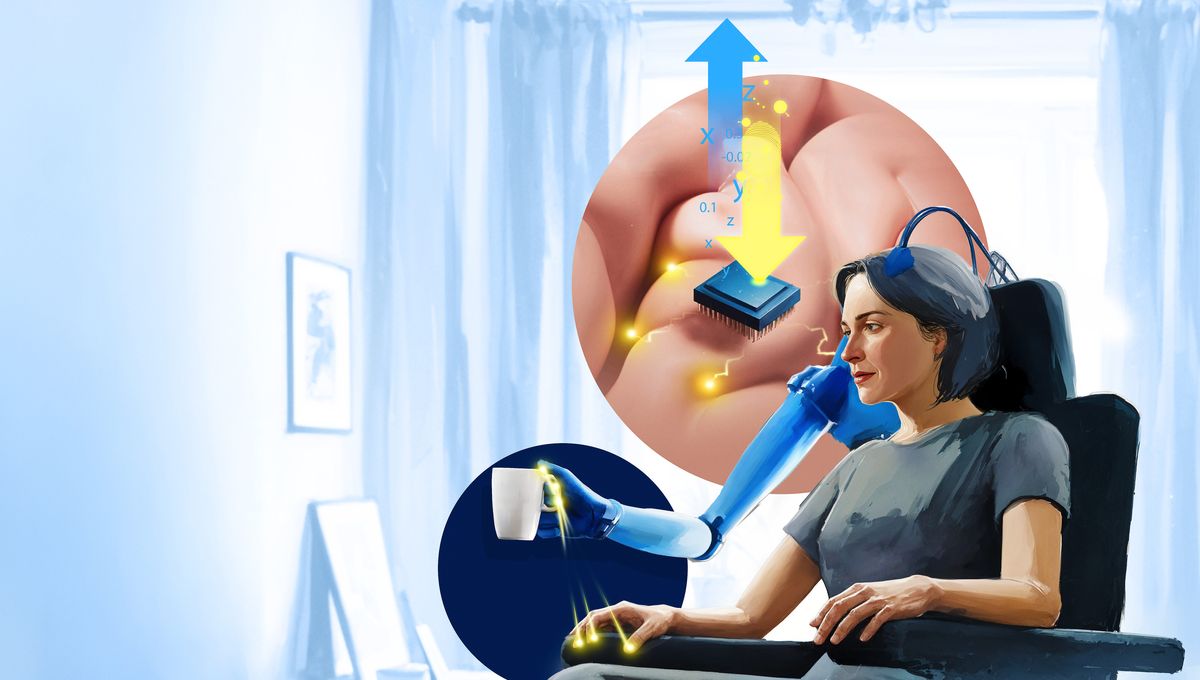
Scientists are pushing the boundaries of what can be achieved with brain-computer interfaces (BCIs) by using brain stimulation to evoke a sense of touch in users of a bionic arm. The device, which attaches to a chair or wheelchair, is designed to help people with paralysis experience the feel of objects in a way that hasn’t been possible up to now.
BCIs form a bridge between a patient’s brain and a device that performs some function that their body is unable to. Some BCIs give a voice to patients who are unable to speak; some can translate thoughts into typed words; and, perhaps most famously right now, Elon Musk’s Neuralink has developed a brain implant to allow people to control a computer using “telepathy”.
Prosthetic limbs, meanwhile, are a surprisingly old medical innovation, but today’s models are a far-cry from the medieval versions, impressive though they were for the time. Recent advances are enabling more naturalistic movement of prostheses, but something that’s trickier to replicate is sensation.
This latest award-winning research from an international team details a new method of encoding complex touch sensations into a bionic hand for the first time, using precisely targeted microstimulation of the brain.
Lead author Professor Giacomo Valle described the work in a statement as going “beyond anything that has been done before” in BCI research.
“We conveyed tactile sensations related to orientation, curvature, motion and 3D shapes for a participant using a brain-controlled bionic limb. We are in another level of artificial touch now.”
In patients with paralysis caused by a spinal cord injury, the electrical signals that would normally carry tactile information from the hand to the brain are blocked. We tend to focus more on our senses of sight and hearing, but the sense of touch is just as important, constantly providing our brains with abundant data about the world around us.
“We think this richness is crucial for achieving the level of dexterity, manipulation, and a highly dimensional tactile experience typical of the human hand,” said Valle.
The bionic arm in this study is extracorporeal, so it’s not attached to the patient’s body. Instead, it is designed to be used by people with paralysis by attaching to a wheelchair or other equipment.
There were two participants in the study, who had been fitted with BCIs and monitored by the scientists for several years to collect data on all the electrical signal patterns in the brain that are associated with movements of the arm and hand – this brain activity is still there, even in people who can no longer move their limbs voluntarily.
Then, when it was time to test out the bionic limb for real – including operating a steering wheel – the scientists developed a way of sending sensory “messages” directly to the brain via the implant. By stimulating the brain in a very specific and targeted way, they can cause the user to feel tactile sensations.
“We found a way to type these ‘tactile messages’ via microstimulation using the tiny electrodes in the brain and we found a unique way to encode complex sensations. This allowed for more vivid sensory feedback and experience while using a bionic hand,” Valle explained.
In real terms, this meant the participants could sense the direction of motion along the fingertips of the bionic hand and feel the edges of objects. Having this extra sensation means tasks like picking up and moving objects can be done with much more accuracy.
For now, as highlighted by Fred Schwaller in a Nature News feature, these breakthrough technologies are limited to very small numbers of people enrolled in clinical trials. Larger trials will be the next step, and then there are critical questions around issues like the cost, regulation, and how to ensure patients with devices will be supported long term.
The team behind this study describe it as a “first step”. “Although many challenges remain,” Valle told Gizmodo, “this latest study offers evidence that the path to restoring touch is becoming clearer.”
The study is published in the journal Science.
Source Link: Sense Of Touch In Bionic Arm Hits “Another Level” Through Cutting-Edge Brain Stimulation